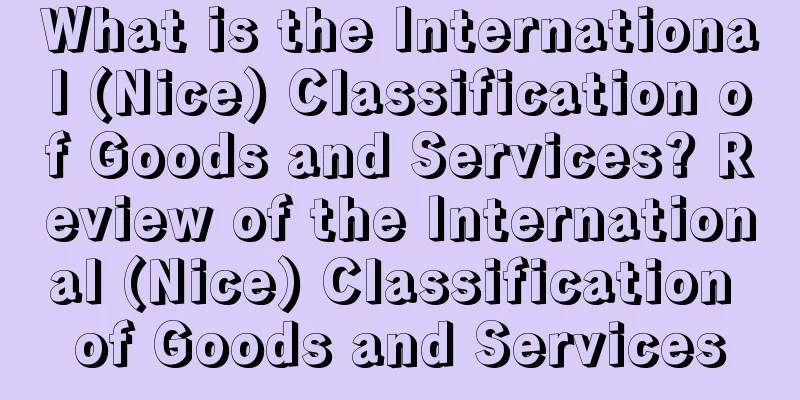What is the International (Nice) Classification of Goods and Services? Review of the International (Nice) Classification of Goods and Services

|
The International Classification of Goods and Services for the Purposes of Registration of Marks (Nice Classification) was formally signed at the Nice Diplomatic Conference in France on June 15, 1957, and came into force on April 8, 1961. Its full name is the Nice Agreement Concerning the International Classification of Goods and Services for the Purposes of Registration of Marks (Nice Agreement). It is generally revised every five years, one is to add new goods, and the other is to adjust the goods already included in the classification according to the new viewpoints, so that the goods have more internal unity. Classification trademarks Origin of the Nice Classification The Nice Classification is based on a multilateral treaty administered by WIPO. The treaty was finalized on June 15, 1957 in Nice, France, and is known as the "Nice Agreement Concerning the International Classification of Goods and Services for the Purposes of the Registration of Marks". The Nice Agreement is open to States party to the Paris Convention for the Protection of Industrial Property. app National trademark offices of signatory countries to the Nice Agreement agree to use designated classification codes in their official documents and publications. Advantages and uniqueness The advantage of using the Nice Classification by national trademark offices is that trademark applications can be coordinated with reference to a single classification system. This greatly simplifies applications, as the goods and services covered by a particular trademark will be classified in the same classes in all countries that have adopted the system. The Nice Classification exists in multiple languages, which also saves applicants a lot of work when filing international applications. Global use As of January 2014, there are 84 signatories to the Nice Agreement; these countries have officially adopted the Nice Classification and apply it to trademark registrations. In addition, 65 non-member countries, four organizations and WIPO also use the Nice Classification. Nice Classification Structure The Nice Classification consists of class headings, explanatory notes and an alphabetical list of goods and services. The class headings are the official descriptive names of the 34 categories or "classes" of goods and 11 classes of services. Where appropriate, these notes are accompanied by explanatory notes providing detailed descriptions of the types of products or services included in the respective class. Approximately 10,000 goods and approximately 1,000 services are listed alphabetically. The Treaty is constantly revised by the Nice Union Committee of Experts, whose members represent all signatory countries, and a new edition is published every five years. The current (eleventh) edition came into force on January 1, 2017. Class List (11th Edition) commodity Category I Chemicals for industrial, scientific, photographic, agricultural, horticultural and forestry use; unprocessed artificial synthetic resins; unprocessed plastic substances; fertilizers; fire extinguishing compositions; preparations for quenching and metal welding; chemicals for preserving food; tanning substances; industrial adhesives Pigments , varnishes, lacquers, rust and wood preservatives, colorants, mordants, unprocessed natural resins, metal foil and powders for painters, decorators, printers and artists Class 3: Bleaching preparations and other substances for laundry use; cleaning, polishing, stain removing and abrasive preparations; soaps; perfumes, essential oils, cosmetics, hair lotions, toothpaste and tooth powder Class 4 Industrial greases, lubricants, dust absorbing, spraying and binding products, fuels (including motor gasoline) and lighting materials, candles, wicks Category 5: Pharmaceuticals, veterinary drugs and sanitary products, medical nutrition products, baby food, plasters, bandage materials, materials for filling holes and dental molds, disinfectants, products for killing harmful animals, fungicides, herbicides Class 6: Common metals and their alloys, metal building materials, movable metal buildings, metal materials for rails, cables and wires for non-electrical use, small hardware, metal pipes, safes, common metal products not included in other categories, mineral sands Class 7: Machines and machine tools, motors (except for motor vehicles), couplings and belts for machine transmission (except for motor vehicles), agricultural tools, incubators Class 8: Hand tools and implements (hand-operated), cutlery, sabres, razors Category 9: Scientific, nautical, geodetic, electrical, photographic, cinematographic, optical, weighing, measuring, signaling, inspection (supervision), first aid (rescue) and teaching instruments and apparatus; apparatus for recording, communicating and reproducing sound and images; magnetic data carriers; recording disks; mechanical structures for automatic vending machines and coin-operated starters; cash receipt recorders; computers and data processing equipment; fire-fighting equipment Class 10: Surgical, medical, dental and veterinary instruments and apparatus, artificial limbs, eyes and teeth, orthopaedic articles, suture materials Class 11: Lighting, heating, steam, cooking, refrigerating, drying, ventilating, water supply and sanitary equipment and appliances Category 12 vehicles, land, air and sea vehicles Class 13: Firearms, ammunition and bullets, explosives and fireworks Class 14: Precious metals and their alloys, articles made of precious metals or coated with precious metals and not included in other classes, jewellery, ornaments, gemstones, clocks and timepieces Category 15: Musical instruments Class 16: Paper, paperboard and articles thereof, not included in other classes; printed matter, bookbinding materials, photographs, stationery, adhesives for stationery or household use, art supplies, brushes, typewriters and office supplies (except furniture); educational or teaching supplies (except instruments); plastic packaging articles (not included in other classes); playing cards, printing type, printing blocks Class 17: Rubber, gutta-percha, gum, asbestos, mica and products made from these materials, not included in other classes; semi-finished plastic products for use in production; packaging, filling and insulating materials; non-metallic hoses Class 18 Leather and imitations of leather not included in other classes; furs; trunks and travelling bags; umbrellas, parasols and walking sticks; whips and saddlery Class 19: Non-metallic building materials, non-metallic rigid pipes for construction, asphalt, asphalt, movable non-metallic buildings, non-metallic monuments Class 20. Furniture; mirrors; mirror frames; articles of wood, cork, reed, rattan, wicker, horn, bone, ivory, whalebone, shell, amber beads, mother-of-pearl, meerschaum, substitutes for these materials or of plastics, not included in other classes Class 21: Household or kitchen utensils and containers (not made of precious metals, nor plated with precious metals, etc.), combs and sponges, brushes (except paintbrushes), brush-making materials, cleaning utensils, steel wool, unworked or semi-worked glass (except architectural glass), glassware, porcelain and earthenware not included in other classes Class 22: Cables, ropes, nets, tents, awnings, tarpaulins, sails, bags (not included in other classes), padding and stuffing materials (except rubber or plastics), raw fibre materials for textile use Class 23 Textile yarn and thread Class 24: Fabrics and textile products not included in other classes, bed sheets and tablecloths Class 25 Clothing, shoes and hats Class 26 : Lace and embroidery, ribbons and braids, buttons, collar hooks, brooches and sewing needles, artificial flowers Class 27 Carpets, mats, mats, linoleum and other floor coverings, non-textile wall hangings Class 28: Entertainment articles, toys, sports and exercise equipment not included in other classes, Christmas tree decorations Class 29: Meat, fish, poultry and game; gravy; pickled, dried and cooked fruit and vegetables; jellies, jams, eggs, milk and dairy products; edible fats and oils; sauces for salads; canned goods Class 30: Coffee, tea, cocoa, sugar, rice, starch, sago, coffee substitutes, flour and cereal products, bread, cakes and confectionery, iced products, honey, syrup, fresh yeast, baking powder, salt, mustard, vinegar, sauces (except sauces for salads), spices for seasoning, drinking ice Class 31: Agricultural, horticultural and forestry products and cereals not included in other classes; livestock; fresh fruits and vegetables; seeds; plants and flowers; animal feed; malt Class 32: Beer, mineral and aerated waters and other non-alcoholic beverages, fruit drinks and juices, syrups and other preparations for use as beverages Class 33: Alcoholic beverages (except beer) Class 34: Tobacco, smoking articles and matches Serve Class 35: Advertising; commercial operations; business management; office affairs. Class 36. Insurance; financial affairs; monetary affairs; real estate affairs. Class 37: Construction services; installation and repair services; mining, oil and gas drilling. Category 38: Telecommunications services. Class 39 : Transport; packaging and storage of goods; travel arrangements. Class 40: Materials handling; recycling of waste and garbage; air purification and water treatment; printing services; preservation of food and beverages. Category 41 : Education; provision of training; entertainment; and cultural and sports activities. Class 42: Scientific and technological services and related research and design services; industrial analysis, industrial research and industrial product design services; quality control and quality certification services; design and development of computer hardware and software. Class 43 Services providing food and beverages; temporary accommodation. Class 44 : Medical services; veterinary services; hygiene and beauty services for humans or animals; agricultural, aquaculture, horticultural and forestry services. Class 45: Legal services; security services providing physical protection for tangible property and persons; private and social services rendered by others to meet personal needs. References |
<<: What is 55haitao - What is 55haitao.com? ? 55haitao - What is 55haitao.com? Review
Recommend
Overstock's Q1 2023 financial report exceeded expectations, but active customers declined
Recently, Overstock, an American home furnishing e...
What is Wangji Overseas Warehouse (007EX Overseas Warehouse)? Wangji Overseas Warehouse (007EX Overseas Warehouse) Review
007EX is a cross-border warehouse and distribution...
What is Western Union? Western Union Review
Western Union is the abbreviation of Western Union...
What is Time100? Time100 Review
"Time100" is China's first Internet ...
Unilever recalls dry shampoo due to carcinogenic ingredients!
Unilever has recalled certain aerosol dry shampoos...
Benefiting from the increase in website visits during the peak sales season! Etsy is optimistic about the fourth quarter!
AMZ23 learned that according to a research report ...
What is Fanzle? Fanzle Review
Fanzle is a tool that focuses on analyzing Amazon ...
With many European countries boycotting Amazon, can sellers still achieve booming sales on Black Friday?
Recently, Amazon's Black Friday promotion is b...
Why can’t low-priced products ultimately rely on advertising?
I went to Foshan to visit a friend's factory o...
What is Barclays Bank? Barclays Bank Review
Barclays Bank is one of the world's largest ba...
Social commerce: the next wave of online shopping
According to SeekingAlpha, the world's largest...
FBA policy changes again? Defect rate over 50% will be banned for 30 days!
Normal, once there is data abnormality, such as s...
Amazon releases new store performance! Violations may result in store closure
Amazon recently launched a new feature in the bac...
FDA cancels the production franchise of disinfectant hand sanitizer! Production will be stopped from December 31st!
The U.S. Food and Drug Administration (FDA) announ...
Amazon Product Condition Buyer Complaints - Solutions to Product Errors
1. First, go to the buyer's voice to find an ...








![The most comprehensive Amazon question manual [E-mail required]](/upload/images/67e77bc91df36.webp)
